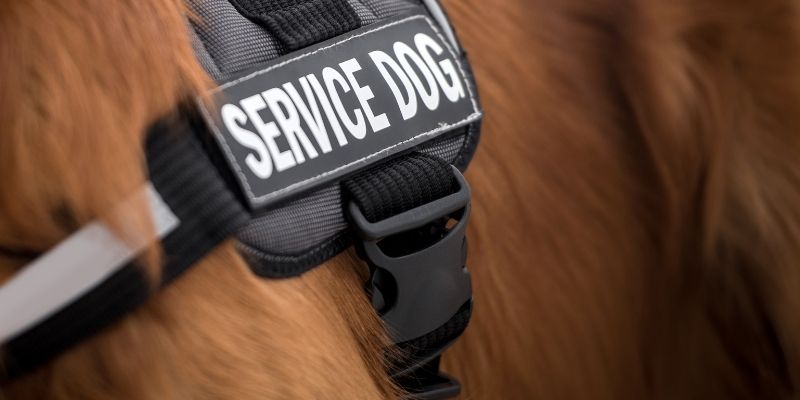Post-traumatic stress disorder (PTSD) can happen in those exposed to or who have witnessed a terrifying or life-threatening event. Reactions are often debilitating and can last for years.
These reactions can range from nightmares to flashbacks, anger, and detachment from society. Individuals may panic in public spaces or be unable to complete daily tasks due to severe depression, anxiety, or hypervigilance.
An increasingly used and effective treatment method for helping a person with PTSD is psychiatric service dogs. These highly trained animals are often referred to as PTSD service dogs.
Do you have a specific question about tasks performed by the psychiatric service dogs? Then use the table of contents below to jump to the most relevant section. And you can always go back by clicking on the black arrow in the right bottom corner of the page. Also, please note that some of the links in this article may be affiliate links. For more details, check the Disclosure section at the bottom of the page.
Here's what we'll cover:
What is a psychiatric service dog?

Treatment plans for PTSD vary by individual needs and often include therapy and medication. Besides, those suffering from PTSD may benefit from a partnership with a PTSD service dog.
These dogs are trained to recognize and react to their handler’s PTSD symptoms, thereby preventing or mitigating the impact. This, in turn, can aid the handler in performing everyday tasks.
Psychiatric Service Dogs are just like any other service animal. They are individually trained in compliance, complete activities, and work in distracting public settings from alleviating their partner’s psychiatric condition. Their role is not to provide emotional support but to perform tasks that allow their partner to function in the ordinary way that the disabled take for granted.

PTSD service dog organizations
Your local Veterans Administration (VA) Service Center can refer you to organizations that help you begin the process of connecting with your canine partner. Here are some reputable organizations:
- Veteran’s Puppy for Life
- Guardian Service Dogs
- Victory Service Dogs
- Freedom Service Dogs of America
- K9s for Warriors

How do service dogs help with PTSD?
A service dog presents numerous benefits for someone suffering from PTSD. Here are a few non-task benefits and effects for a person with PTSD having a psychiatric service dog.
Promote social interaction.
Accepting responsibility for the care of a service dog means accepting specific social interactions, such as training sessions, going for walks, and veterinary visits. A dog provides a reason to leave the house, along with a requirement to interact. The dog also acts both as a conversation bridge and an excuse to leave a stressful or uncomfortable situation, if needed.
Provide companionship.

One of the most basic things a dog provides is one-on-one companionship. This devotion can help to rebuild trust in others for someone suffering from PTSD.
Promote physical activity.
Through the act of caring for a dog, a person can engage in anything from light to strenuous physical activity. The light activity includes daily walks, playing with the dog, or attending training sessions. Additionally, for those who seek it, a dog can be a partner for more strenuous physical activities, such as hiking or running. Regular physical activity can improve a sense of well-being for someone suffering from PTSD.
Give a sense of purpose.
Finally, a dog can give a sense of purpose. The handler with PTSD relies on the dog for help with their daily tasks. But the dog also relies on their handler for food and care. This can give a sense of purpose to someone who needs it in their daily lives.

Psychiatric Service Dog Tasks

Dogs are truly amazing animals. In addition to the many benefits listed above, PTSD service dogs are trained to perform specific tasks that mitigate their handler’s symptoms. Willing to work and with a strong desire to bond and please, they are incredible partners in treating someone with PTSD. Just as no one’s PTSD is the same, so it goes with service dog training. The following are some of the many tasks a PTSD service dog can perform:
- Bring medication in an emergency. Example: A person with PTSD with debilitating anxiety experiences severe gastric distress when overstressed. They fall to the ground and cannot rise. The dog is trained to retrieve anti-nausea medication.
- Detect rising cortisol levels. Dogs have anywhere from 200 to 300 million scent receptors in their noses. They learned to associate different scents with different situations throughout their domestication, including sensing the rising cortisol levels in human sweat or breath. They then perform an action intended to help their handler recognize or reduce their stress.
- Give reminders about medication. Medication is an essential part of many Post Traumatic Stress Disorder treatment plans. And consistency with taking that medication can positively impact the individual’s management of their symptoms. If remembering to take medicine is a hindrance to the treatment plan, a PTSD service dog can be trained to remind their handler to take their medication. They can even retrieve the pills along with the water if needed.

- Wake from nightmares. Common challenges for those suffering from Post Traumatic Stress Disorder are nightmares or night terrors. The PTSD service dog learns to recognize indications that its handler is having a nightmare. They can then turn on lights, gently awaken their handler, providing a source of comfort and grounding through tactile sensations.
- Create a safe space. Feelings of anxiety associated with PTSD can be heightened when in a public space. Psychiatric service dogs can scan any room or public space for potential triggers and assure their handler that the area is safe. If the dog discovers a possible trigger, it can lead its handler to an exit to avoid the situation.
- Create a physical barrier. Within public spaces, PTSD service dogs can act as a physical barrier, thus providing a measure of security for their handler. By positioning their body between their handler and others or circling their handler, the dogs can create space in a non-aggressive manner.

- Provide a reassuring presence. When in a public space, a psychiatric service dog can be trained to look in the opposite direction of the handler, thus providing the security of someone watching the handler’s back. The dog can give a signal to alert the handler if someone approaches from behind. These actions can help if the handler tends toward hypervigilance and needs the extra assurance to feel safe in a public space.
- Interrupt panic attacks or flashbacks. There are many ways a psychiatric service dog can respond if their handler has a panic attack. First, the dog learns to recognize the indications that a panic attack is imminent. The dog can then perform an action to alleviate that attack. The action is unique to each handler, as every person’s needs are different.
- Call for help. Not only can PTSD service dogs be trained to get another person to help their handler, but the dog can also use technology to call for help. The FIDO Project at Georgia Tech is an ongoing effort to facilitate communication between handlers and their working canine companions. One of their projects involved designing a TV-sized touch screen connected to a computer. A service dog can use it to call emergency services, a doctor, a therapist, or a suicide prevention hotline.
- Guide during a dissociative episode. Sometimes the handler might experience an altered perception of reality, resulting in confusion or panic. PTSD service dogs can be trained to recognize the physical cues that their handler gives during such an event. The dog can then guide their handler out of the situation or home so that they can recover.
Some of the other tasks include identifying hallucinations, guide a disoriented handler, finding a person, things, or places, help with the balance. And the list goes on.

How to train a service dog for PTSD?

Trainers look for specific traits when scouting potential dogs for PTSD service training. Some characteristics are physical. For example, a dog must be of adequate size and strength for the tasks it is intended to perform.
Other traits are less tangible. Service dogs must be perceptive and able to detect things in the environment that could potentially trigger their handler. They must be sensitive to physical and verbal cues given by their handler that indicate care is required. Also, they need to perform these duties independently when their handler is in crisis.
Each person requiring a service dog as part of their PTSD treatment and management plan has different needs. Therefore, each dog is trained to react as their handler needs to prevent or respond to the specific circumstance. For example, to detect cortisol levels, the dog is exposed to cortisol samples taken from their intended handler. They then receive rewards for performing an action upon detection of that scent.
Professional dog trainers select and train most service dogs, matching them to a list of qualified recipients. The dog and handler typically go through a training period where the handler learns the proper commands to give the dog and the signals the dog may give in return to mitigate the handler’s PTSD.
Individual training plans are available where the handler can train their own dog, including dogs they already own as pets.

Service dog for PTSD requirements
According to the National Service Animal Registry, it is not enough to have a mental illness to qualify for a disability under the ADA. Some 26% of people in the U.S. have a mental disorder in any given year, but just 6% have a serious mental illness. As a result, more than three-quarters of people with a diagnosed mental condition are not disabled. They would not be eligible to use a service animal even though they benefited from one.
Far more than a pet, psychiatric service dogs are an essential part of a strategy to manage PTSD. However, they are only one piece of that strategy. They aren’t intended to replace other aspects of that plan, such as medication or therapy.
To qualify as a PTSD service dog, the dog must be trained to perform a specific task that allows their handler to go about their daily activities. Together, the handler and the dog are companions working to facilitate care.
For additional information on service dog requirements and training, contact National Service Animal Registry or your local VA Service Center for additional information. For help finding a local VA location, click here.
Thanks for the blog graphics: Canva.com


